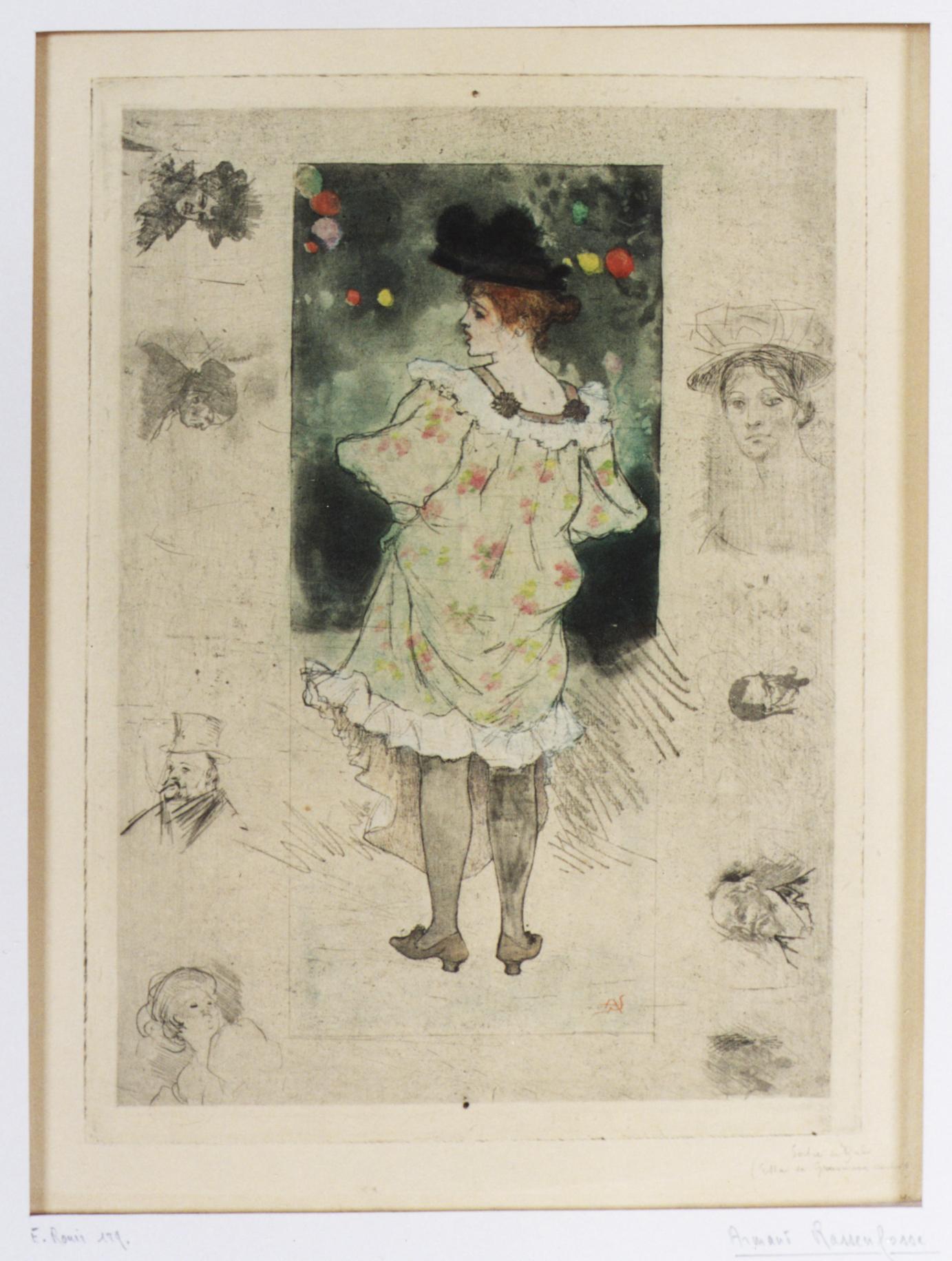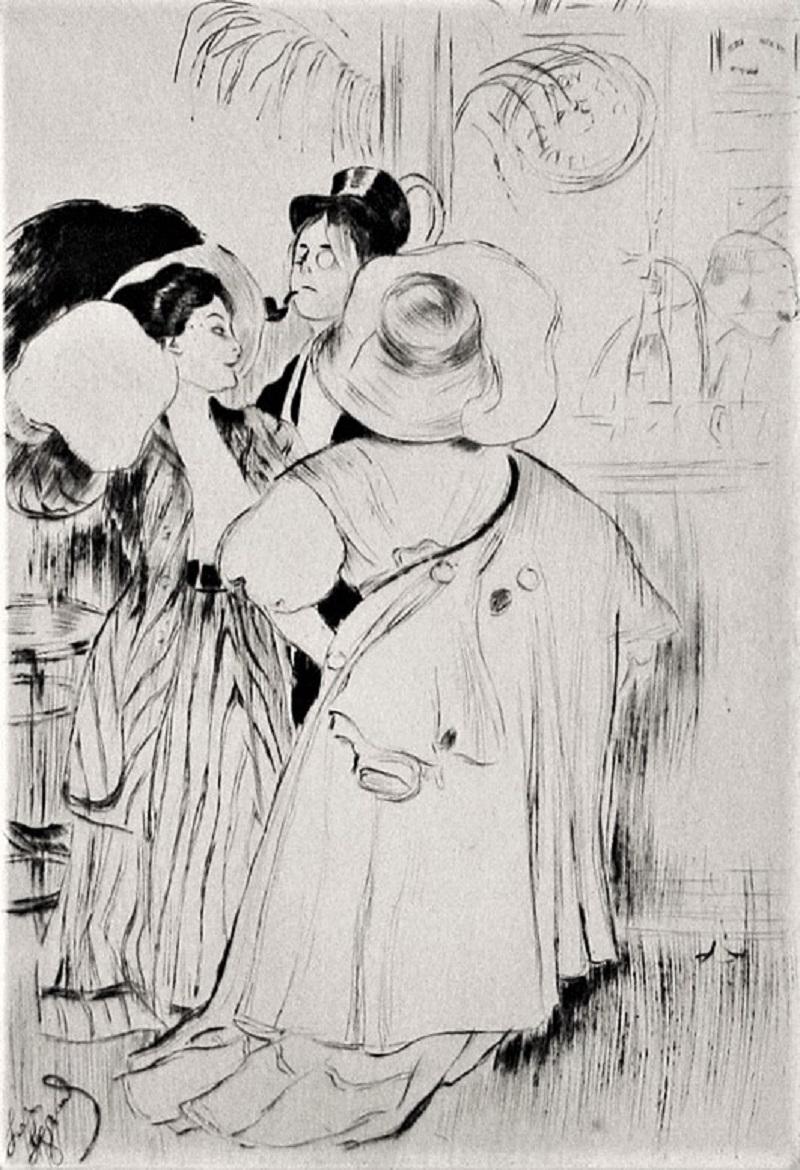Louis LegrandLa Toilette1908
1908
About the Item
- Creator:Louis Legrand (1863 - 1951, French)
- Creation Year:1908
- Dimensions:Height: 7.88 in (20.02 cm)Width: 5.63 in (14.31 cm)
- Medium:
- Movement & Style:
- Period:
- Condition:
- Gallery Location:Fairlawn, OH
- Reference Number:
Louis Legrand
Louis Legrand was born in Dijon, France, on September 29, 1863. He worked as a bank teller and studied art at the Dijon Ecole des Beaux-Arts in his spare time. At the age of 20, he won the Devosge prize at that school and a year later left for Paris. Legrand arrived in Paris in 1884, where he studied under Felicien Rops and soon became famous for his paintings, drawings and etchings depicting the Parisian beau-monde. A superb draughtsman, his etchings also show great sophistication. Legrand's prints were almost all published by Gustave Pellet, who published many erotic images.
- ShippingRetrieving quote...Ships From: Fairlawn, OH
- Return PolicyA return for this item may be initiated within 10 days of delivery.
- Woman's Head (Vrouwekop), Marguerite Adolphine HelfrichBy Jan TooropLocated in Fairlawn, OHWoman's Head (Vrouwekop), Marguerite Adolphine Helfrich Drypoint, 1897 Signed lower right in pencil: J Toorop; by later hand Toorop's model for this print was Marguerite Adolphine H...Category
1890s Jugendstil Figurative Prints
MaterialsDrypoint
- La PromenadeBy Edgar ChahineLocated in Fairlawn, OHLa Promenade Etching, soft-ground, aquatint & drypoint, Signed in pencil lower left Published by Edmund Sagot, Paris Edition of 50 in black only, aside from the edition of 50 in co...Category
Early 1900s Art Nouveau Figurative Prints
MaterialsDrypoint, Etching, Aquatint
- Portrait de petite fille, en buste, cheveux sur les epaules (Ellen 14 ans)By Paul César HelleuLocated in Fairlawn, OHPortrait de petite fille, en buste, cheveux sur les epaules (Ellen 14 ans) Portrait of a little girl, bust, hair on shoulders) Drypoint, 1902 Signed lower right corner Very small edition Portrait of the artist's daughter Ellen, at age 14. Title inscribed into the plate upper left Brilliant impression full of burr No stated edition, proofs only, less than 10 imps Unidnetified collector's mark verso: Initials "PH", not in Lugt Reference: Laran, IFF No. 390 Condition: Excellent Image/Plate eize: 14 3/4 x 12 5/8 inches Sheet size: 25 x 16 inches "Paul César Helleu was born in Vannes, Brittany, France. His father, who was a customs inspector, died when Helleu was in his teens. Despite opposition from his mother, he then went to Paris and studied at Lycée Chaptal. In 1876, at age 16, he was admitted to the École des Beaux-Arts, beginning academic training in art with Jean-Léon Gérôme. Helleu attended the Second Impressionist Exhibition in the same year, and made his first acquaintances with John Singer Sargent, James McNeill Whistler, and Claude Monet. He was struck by their modern, bold alla prima technique and outdoor scenes, so far removed from the studio. Following graduation, Helleu took a job with the firm Théodore Deck Ceramique Française hand-painting fine decorative plates. At this same time, he met Giovanni Boldini, a portrait painter with a facile, bravura style, who became a mentor and comrade, and strongly influenced his future artistic style. When he was 18 years old, Helleu established a close friendship with John Singer Sargent, four years his senior, that was to last his lifetime. Already becoming established, Sargent was receiving commissions for his work. Helleu had not sold anything, and was deeply discouraged almost to the point of abandoning his studies. When Sargent heard this, he went to Helleu and picked one of his paintings, praising his technique. Flattered that Sargent would praise his work, he offered to give it to him. Sargent replied, "I shall gladly accept this, Helleu, but not as a gift. I sell my own pictures, and I know what they cost me by the time they are out of my hand. I should never enjoy this pastel if I hadn't paid you a fair and honest price for it." With this he paid him a thousand-franc note. Helleu was commissioned in 1884 to paint a portrait of a young woman named Alice Guérin (1870–1933). They fell in love, and married on 28 July 1886. Throughout their lives together, she was his favourite model. Charming, refined and graceful, she helped introduce them to the aristocratic circles of Paris, where they became popular fixtures. On a trip to London with Jacques-Émile Blanche in 1885, Helleu met Whistler again and visited other prominent artists. His introduction to James Jacques Tissot, an accomplished society painter from France who made his career in England, proved a revelation. In Tissot, Helleu saw, for the first time, the possibilities of drypoint etching with a diamond point stylus directly on a copper plate. Helleu quickly became a virtuoso of the technique, drawing with the same dynamic and sophisticated freedom with his stylus as with his pastels. His prints were very well received, and they had the added advantage that a sitter could have several proofs printed to give to relations or friends. Over the course of his career, Helleu produced more than 2,000 drypoint prints. Soon, Helleu was displaying works to much acclaim at several galleries. Degas encouraged him to submit paintings to the Eighth Impressionist Exhibition in May and June 1886. The show was installed in a Paris apartment at 1 rue Laffitte, which ran concurrently with the official Salon that year to make a statement. Although 17 artists joined the famous exhibit that included the first Neo-Impressionistic works, Helleu, like Monet, refused to participate. Paul Helleu Sketching with His Wife (1889), by John Singer Sargent, The Brooklyn Museum, New York In 1886, Helleu befriended Robert de Montesquiou, the poet and aesthete, who bought six of his drypoints to add to his large print collection. Montesquiou later wrote a book about Helleu that was published in 1913 with reproductions of 100 of his prints and drawings. This volume remains the definitive biography of Helleu. Montesquiou introduced Helleu to Parisian literary salons, where he met Marcel Proust, who also became a friend. Proust created a literary picture of Helleu in his novel Remembrance of Things Past as the painter Elstir. (Later, Helleu engraved a well-known portrait of Proust on his deathbed.) Montesquiou's cousin, the Countess Greffulhe, enabled Helleu to expand his career as a portrait artist to elegant women in the highest ranks of Paris society, portraits that provide the basis for his modern reputation. His subjects included the Duchess of Marlborough, the Marchesa Casati, Belle da Costa Greene, Louise Chéruit, and Helena Rubinstein. Looking for new inspiration, Helleu began a series of paintings and color prints of cathedrals and stained glass windows in 1893, followed by flower studies and landscapes of parks in Versailles. Helleu took up sailing, owning four yachts over his life. Ships, harbor views, life at port in Deauville, and women in their fashionable seaside attire became subjects for many vivid and spirited works. In 1904, Helleu was awarded the Légion d'honneur and became one of the most celebrated artists of the Edwardian era in both Paris and London. He was an honorary member in important beaux-arts societies, including the International Society of Painters, Sculptors, and Engravers, headed by Auguste Rodin, and the Société Nationale des Beaux-Arts. On his second trip to the United States in 1912, Helleu was awarded the commission to design was the ceiling decoration in New York City's Grand Central Terminal. He decided on a mural of a blue-green night...Category
Early 1900s Art Nouveau Figurative Prints
MaterialsDrypoint
- Bare Arms (The Practice #2)By Darius StewardLocated in Fairlawn, OHBare Arms (The Practice #2) Drypoint on Aluminum, 2019 Signed with initials lower right Edition: 8 impressions (all uncolored), this “6 out of 8” There are also 4 AP, 2 with hand coloring Printed on Twinrocker all purpose paper Published by Thomas French Fine Art...Category
2010s Contemporary Figurative Prints
MaterialsDrypoint
- Bare Arms (The Practice #1)By Darius StewardLocated in Fairlawn, OHBare Arms (The Practice #1) Drypoint on Aluminum, 2019 Signed with the artist's initials (see photo) The first plate from a proposed suite of 9 drypoints, all printed in an edition o...Category
2010s Contemporary Figurative Prints
MaterialsDrypoint
- Keresan DancersBy Gene KlossLocated in Fairlawn, OHKeresan Dancers Etching & drypoint, 1962 Signed lower right (see photo) Inscribed lower left: "Artist's Proof Keresan Dancers" Depicts Keresan speaking peoples at Sam Felipe Pue...Category
1960s American Realist Figurative Prints
MaterialsDrypoint
- Sortie De Bal - After The BallBy Armand RassenfosseLocated in New York, NYRassenfosse, Armand.( 1862-1934) Sortie De Bal, 1894. Original drypoint in colors on Japan, initialled in red ink by artist with his monogram. Beautiful impression. In addition, the ...Category
1890s Art Nouveau Figurative Prints
MaterialsDrypoint
- English BarBy Louis LegrandLocated in Storrs, CTEnglish Bar. 1908. Etching and drypoint. Exsteens catalog 275 state ii. 8 1/8 x 5 5/8 (sheet 17 3/8 x 12 1/4). Series: Les Bars. Edition 65 in this state (total edition 95). Printed ...Category
Early 1900s Art Nouveau Figurative Prints
MaterialsDrypoint, Etching
- Dornröschen (Sleeping Beauty.)By Heinrich VogelerLocated in Storrs, CTReif 20.IIc(of e). 10 5/8 x 9 3/4 (sheet 19 X 12 3/4). Slight scattered foxing in the margins, away from the image. A rich, tonal impression printed on sturdy wove paper. Proof aside...Category
Late 19th Century Jugendstil Figurative Prints
MaterialsFiberglass, Drypoint, Etching, Aquatint
- "Portrait of Madame Georges Menier" By HelleuBy Paul César HelleuLocated in Hinsdale, ILHELLEU, PAUL CÉSAR (1859 - 1927) MADAME GEORGES MENIER Montesquiou XXI Drypoint in colors, c. 1900 Signed in pencil, lower right Printed on wove paper Full Margins 22 1/4” x 13...Category
Early 19th Century Art Nouveau Figurative Prints
MaterialsEtching, Drypoint
- Couple Under a TreeBy Elyse Ashe LordLocated in New York, NYElyse Ashe Lord (1900-1971), Couple Under a Tree, c. 1930, color etching, soft ground, drypoint; signed lower right in pencil and numbered by the artist lower left. In very good condition, the full sheet, 11 3/4 x 12 1/4, the sheet 17 x 16 inches. A fine impression, with strong colors and plate tone. Printed on a light laid ivory Japan...Category
1930s Art Nouveau Figurative Prints
MaterialsEtching, Drypoint
- "Woman with Cello, " Wood Engraving signed by Gillot after Eugene GrassetBy Eugène GrassetLocated in Milwaukee, WI"Woman with Cello" is a wood engraving by Gillot after Eugene Grasset. The artist signed the piece in the lower right. It depicts a woman with long fl...Category
1890s Art Nouveau Figurative Prints
MaterialsEngraving





